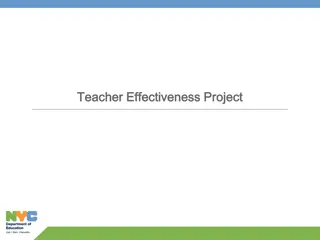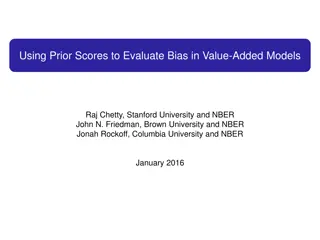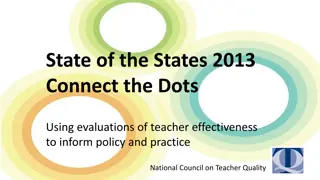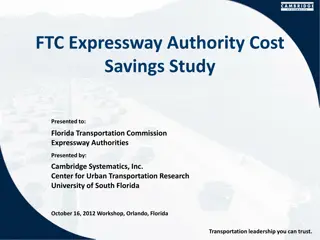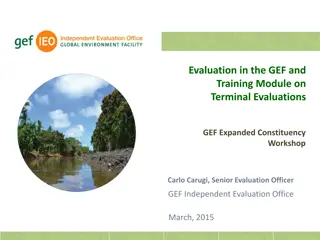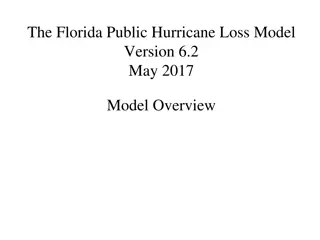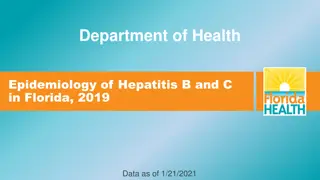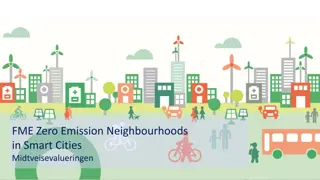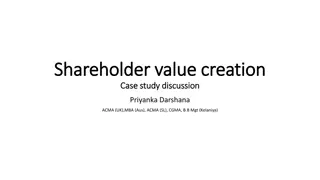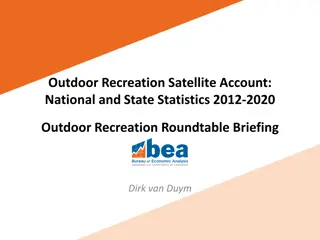Florida's Value-Added Model for Teacher Evaluation
Florida's Value-Added Model and the new standards for teacher evaluations aim to measure student learning growth effectively. The model, developed by Florida educators with input from various stakeholders, emphasizes using data from assessments to evaluate teacher performance. The Student Growth Implementation Committee (SGIC) played a pivotal role in developing and adopting the recommended evaluation model. Teachers, school administrators, and district-level personnel all contribute to the evaluation process, ensuring it aligns with sound educational principles and contemporary research practices.
Download Presentation

Please find below an Image/Link to download the presentation.
The content on the website is provided AS IS for your information and personal use only. It may not be sold, licensed, or shared on other websites without obtaining consent from the author.If you encounter any issues during the download, it is possible that the publisher has removed the file from their server.
You are allowed to download the files provided on this website for personal or commercial use, subject to the condition that they are used lawfully. All files are the property of their respective owners.
The content on the website is provided AS IS for your information and personal use only. It may not be sold, licensed, or shared on other websites without obtaining consent from the author.
E N D
Presentation Transcript
FLORIDAS VALUE ADDED FLORIDA S VALUE ADDED MODEL MODEL Overview of the Model to Measure Student Learning Growth on FCAT January 2012 1
NEW STANDARD FOR TEACHER EVALUATIONS As set forth in the Student Success Act and Race to the Top, teacher evaluations are: Designed to support effective instruction and student learning growth Used when developing district and school level improvement plans Used to identify professional development and other human capital decisions for instructional personnel and school administrators 2
NEW STANDARD FOR TEACHER EVALUATIONS To support those objectives, the law sets forth that teacher evaluations are to be based on sound educational principles and contemporary research in effective practices: 1. The performance of students IPEGS Standard 1 2. Instructional practice and job responsibilities IPEGS Standards 2-8 or 2-7 3
NEW STANDARD FOR TEACHER EVALUATIONS Performance of Students. At least 50% of a performance evaluation must be based upon data and indicators of student learning growth assessed annually and measured by statewide assessments or, for subjects and grade levels not measured by statewide assessments, by district assessments as provided in s. 1008.22(8), F.S. -Section 1012.34(3)(a)1., Florida Statutes 4
FLORIDAS VALUE-ADDED MODEL DEVELOPED BY FLORIDA EDUCATORS The Department convened a committee of stakeholders (Student Growth Implementation Committee or SGIC) to identify the type of model and the factors that should be accounted for in Florida s value-added models To provide technical expertise, the Department contracted with the American Institutes for Research (AIR) to help the SGIC develop the recommended model that was adopted. The SGIC s recommended model was fully adopted by the Commissioner with no additions, deletions, or changes 5
FLORIDAS VALUE-ADDED MODEL DEVELOPED BY FLORIDA EDUCATORS The Student Growth Implementation Committee (SGIC) is composed of 27 members from across the state. The group includes: Teachers (across various subjects and grade levels, including exceptional student education) School administrators District-level administrators (Assessment and HR) Postsecondary teacher educators Representatives from the business community Parents The SGIC met from March through June 2011 2 two-day in-person meetings 4 conference call meetings 6
FLORIDAS VALUE-ADDED MODEL DEVELOPED BY FLORIDA EDUCATORS After exploring eight different types of value- added models, the SGIC recommended a model from the class of covariate adjustment models This model begins by establishing expected growth for each student: Based on historical data each year Represents the typical growth seen among students who have earned similar test scores the past two years, and share the other characteristics identified by the committee 7
THE NEW MEASURE: VALUE-ADDED ANALYSIS A value-added model attempts to measure the impact of a teacher on student learning, by accounting for other factors that may impact the learning process. These models DO NOT: Evaluate teachers based on a single year of student performance or proficiency (status model) or Evaluate teachers based on simple comparison of growth from one year to the next (simple growth) 8
ADVANTAGES OF VALUE-ADDED MODELS Teachers teach classes of students who enter with different levels of proficiency and possibly different student characteristics Value-added models ATTEMPT to level the playing field by accounting for differences in the proficiency and characteristics of students assigned to teachers Value-added models are designed to MITIGATE the influence of differences among the entering classes so that schools and teachers do not have advantages or disadvantages simply as a result of the students who attend a school or are assigned to a class Value-Added models are not perfect. Model will be continually reviewed by the FLDOE in case adjustments are necessary 9
VALUE-ADDED EXAMPLE Teacher X 500 The difference between the predicted performance and the actual performance represents the value-added by the teacher s instruction. 400 300 The predicted performance represents the level of performance the student is expected to demonstrate after statistically accounting for factors through a value- added model. 200 100 0 Student E Prior Performance Current Performance Predicted Performance 10
WHAT ARE THE SCORES? What is the Predicted Student Score? It is the score you would EXPECT a student to achieve based on the student s performance on prior tests and other information available on the student. A predicted score for a student is generated based on what would normally happen in an average class with a typical teacher. What is the Student Learning Growth Score? The difference between Current test score and Predicted test score. 11
FACTORS USED TO ADJUST PREDICTED SCORE Student Characteristics: Up to two prior years of achievement scores (the strongest predictor of student growth) The number of subject-relevant courses in which the student is enrolled Students with Disabilities (SWD) status English Language Learner (ELL) status Gifted status Attendance Mobility (number of transitions) Difference from modal age in grade (as an indicator of retention) Classroom characteristics: Class size Homogeneity of students entering test scores in the class 12
FACTORS NOT TO ADJUST PREDICTED SCORE NOT USED Student Characteristics NOT directly accounted for: Gender Race Ethnicity Socio-Economic Status These factors are not directly included in a teacher s VAM score. However, since these factors already influence a student s performance and prior performance is the predictor with the strongest weight, they are indirectly accounted for 13
HOW DO THE FACTORS AFFECT THE PREDICTED SCORES AN EXAMPLE In a classroom of 25 students, every student may have a different predicted(expected) score because of the student s individual prior performance and student characteristic variables For example 2 students in the same class with the same teacher: Student A has Prior Year FCAT Reading Score of 1700 Attendance = 10 days absent Student is English Language Learner Student B has Prior Year FCAT Reading Score of 1700 Attendance = no days absent Student is NOT English Language Learner What is the expected score for each of these students ? Student A has an expected score of 1750 and Student B has expected score of 1790 14
WHAT DOES THE PREDICTED SCORE LOOK LIKE AFTER ADJUSTING FOR ATTENDANCE? 16
HOW IS STUDENT LEARNING GROWTH MEASURED? 17
HOW PRECISE IS THIS VAM SCORE? Precision in a VAM score is used to measure the consistency of the individual teacher VAM estimates. It is measuring how much individual teacher VAMS would change if they were computed over and over again. Example: Weighing yourself on a scale 18
WHAT IS STANDARD ERROR IN A VAM SCORE? The standard error gives the uncertainty (error band) surrounding a teacher s VAM score It can be used to prevent classifying teachers when that categorization would be uncertain Standard errors will be used when classifying teachers in the lowest tier to ensure that there is a high degree confidence on this categorization 19
COMPONENTS OF THE OVERALL TEACHER VAM ESTIMATES The model recognizes that there is an independent factor related to the school that impacts student learning aschool component Calculated based on the predicted and observed scores of students in the school for each grade and subject while controlling for the students and classrooms factors mentioned previously May represent the impact of the school s leadership, the culture of the school, or the environment of the school on student learning 20
COMPONENTS OF THE OVERALL TEACHER VAM ESTIMATES SGIC decisions on the use of the school component The SGIC decided to include 50% of the school component in the measurement of the teacher s effectiveness By attributing a portion of the school component to the teacher in the measurement of his/her effectiveness, one recognizes that the teacher contributes somewhat to the overall school component, but there are factors imbedded in that component that are beyond his/her direct control and that he/she should not directly be held accountable for 21
FLDOES CONCEPTUAL CALCULATION FOR A TEACHER VALUE-ADDED SCORE Teacher Value-Added Score is : Teacher Growth Score + 50 percent of the School Growth Score 22
WHAT DOES A VAM SCORE LOOK LIKE? A VAM score represents the amount of a year s growth above or below expectation for a particular grade level and subject area. This teacher s students scored 6.250 DSS points lower than was expected -6.250 -10 -5 0 5 10 5.750 This teacher added 5.750 DSS points above the expected growth to their students 23
WHY NORMALIZING TEACHER VAM SCORES IS IMPORTANT? Teachers may be teaching multiple grade levels and subject areas VAM scores are made comparable by standardizing within grade level and subject area Aggregated standardized VAM scores are converted to percentile ranks within M-DCPS to ensure comparability across grades and subject areas Percentile ranks are used for classification purposes 24
WHY STANDARDIZE THE SCORES? DISTRIBUTION OF 6TH AND 7TH GRADE READING VAM ESTIMATES The graphs demonstrate that the center and spread of the VAM scores differ across grades Therefore, standardizing will ensure comparability across grade levels 25
STEPS TOWARDS CONVERTING THE VAM TO PERCENTILE STANDINGS To create standardized score: 1. Subtract the mean of the distribution from the observed VAM score Grade 6 10 6.7 = 3.3 Grade 7 10 9.2 = 0.8 2. Divide the result by the standard deviation Grade 6 Grade 7 3.3 / 19.5 = 0.17 0.8 / 17 = 0.05 3. Refer the standardized score to the normal distribution to obtain the percentile standing Grade 6 Standard score of 0.17 = 57th percentile Grade 7 Standard score of 0.05 = 52nd percentile VAM Mean Stand. Dev. Standard Score Percentile Grade 6 10 6.7 19.5 0.17 57% Grade 7 10 9.2 17 0.05 52% 26
TEACHER FINAL EVALUATION Teacher s Unified Summative Rating includes two components: Professional Practices - measured by IPEGS Standards 2-8 or 2-7 Quantifiable Student Data IPEGS Standard 1 Measured using a VAM score that has been converted to a percentile rank which is currently the most accurate and objective measure available that can be used to measure student growth The VAM measure takes into account multiple indicators and prior student performance to predict a teacher s value added contribution to a student s academic growth 27
FLORIDAS VALUE ADDED FLORIDA S VALUE ADDED MODEL MODEL Questions 28









